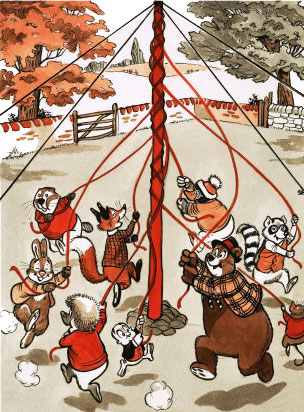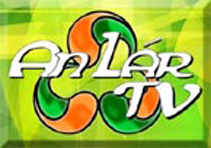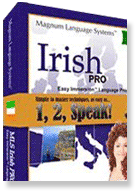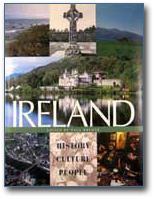Celtic-Holidays
 |
As I began researching about May Day in Ireland, I came upon the following information about the original eight Celtic holidays in the Emerald Isle. I will start out with May Day and continue on with the other seven holidays celebrated by the Celts.
May Day is celebrated on May 1st as it is in most other countries around the world. In Gaelic it is called Beltaine (pronounced Biel-ten-eh). This is one of the original eight Celtic holidays which has been celebrated for centuries. Beltaine was the most sacred of Celtic ritual days. It is the beginning of new life after the harsh winter months, and the time of blossoming flowers and fruit. Beltaine was also related to the fertility of livestock and crops and is commonly associated with fire rites. The most well known of the Beltaine fire rites had to do with driving the herds between bonfires, through their smoke, for purification and protection against evil spirits. The Maypole dance is similar to the traditions of other European countries. Colorful cloth ribbons are draped from a pole and boys and girls, circling in opposite directions, wind the cloth around the pole. This a fun Beltaine ritual which represents the union of life.
A growing number of people raised in various Judeo-Christian religious traditions find themselves attracted to the spiritual traditions of the Celts going back more than 1500 years.
Today, there are thousands of people of Celtic ancestry, and others, who are trying to re-learn the ancient wisdom and spirituality prevalent during the time of Saint Patrick in Ireland, around 432 A.D. Some are discovering Celtic spirituality through Irish history, myth, and poetry, and others through the revival of Irish music and dance. Pilgrimages to sacred sites and courses about Celtic mythology are now common place.
There are groups of individuals who label themselves Celtic "Reconstructionists." Their goal is to reconstruct rituals, organize festivals and conventions, and distribute study courses. They are encouraged to learn spiritual understanding rooted in nature, the land, and protection of the earth. For lack of a better term, those who choose to learn and practice these ancient Celtic ways are referred to as Celtic "reformists."
The Celtic trinity and the shamrock were symbols that had great significance to the Celts. The myth of St. Patrick using the shamrock to preach the gospel of Christianity by comparing its three leaves with the Father, the Son and the holy spirit, was probably derived from the Celtic metaphor of the shamrock representing a "trust in your soul," "belief in your heart" and "faith in your mind". This trinity forms the basis of Celtic spiritual beliefs.
The winter and summer solstice and the spring and fall vernal equinox were celebrated by the Celts and, in between, are the four major holidays. In the Celtic world, days began at sundown, so all holidays commenced at sundown and continued the following day. The sun and the moon and, to some extent, the planets determined the dates of all eight Celtic holidays.
The summer solstice or midsummer's celebration was traditionally celebrated on June 24th. A custom was for all the young folk to stay up for the whole night, keeping watch over a fire. Musical bands and dancers would wander from one fire to the next. A courageous soul might spend the night alone keeping watch in the center of a circle or standing stones, the result being madness or, hopefully, the acquisition of the gifts to become a great bard or poet.
Lughnasa (pronounced Loo-ness-a) is held on August 1st and is the celebration of the God Lugh representing sun and plenitude. This was the summer festival where marriages were consumated and communities celebrated with song and dance. Lughnasa, celebrated from mid July to mid August, was the harvest festival. A great feast would be held on August 1st to celebrate the richness of the harvest and to honor the gods. Unlike other fire festivals, which were essentially family and homestead affairs, Lughnasa was celebrated in the community as a whole. Major assemblies took place, often on the top of high points in the landscape. Dancing and feasting were high on the agenda. Until the 12th century, the Tailltinn games were held on August 1st. These were the equivalent of the Olympic Games of classical Greece and were named after Tailtu, Lugh's foster mother. Afterwards, a bonfire would be lit and there would be dancing and singing around it.
The fall equinox or harvest home represents the fading of summer light and the spirit of fields. '... as the fields go fallow, the spirit of the sun becomes trapped in the corn'. An effigy made of the last sheaf of the harvest is carried from the field and burned at sundown. Harvest home was a time to rest and rejuvenate the spirit from a season of hard work. The fall traditions of drinking cider and harvest ale, enjoying caramel apples and marveling at the harvest moon, are all in line with the Celtic fall tradition.
Samhain (pronounced Sow-en) is held on November 1st, which coincides with Halloween and All Souls Day. This was the holiday to honor ancestors and the dead. Masks were worn so that the spirits might not recognize you and would pass you by for another year. Samhain heralded the start of the Celtic new year. It was celebrated on October 31st and commemorated the creation of order out of chaos and the beginning of the world. During this celebration, the division between this world and the other world dissolved and the spirits roamed the earth. Nearly all of the Halloween rituals have their roots in Samhain.
The winter solstice or Yule coincides with Christmas. This was the Celts time to celebrate the darkest day of the year and look toward the everlasting, hence, the evergreen as the best known symbol of Christmas. Good food and drink was had by all at this Celtic festival. All took part in a drink from the waeshael cup. Nearly all the traditions of Christmas, from caroling to standing under the mistletoe, have Celtic origins.
Imbolc (pronounced em-bolc) was celebrated on February 1st. This holiday, which coincides with Groundhog Day, Candlemas and to some extent Valentines Day, venerates the Celtic Goddess Brigid. She became St. Brigit after her death and was supposedly converted and baptized by St. Patrick. She was associated with miracles and fertility. Into the 18th century, a women's-only shrine was kept to her in Kildare, where nineteen nuns tended her continually burning sacred flame. An ancient song was sung to her: "Brigid, excellent woman, sudden flame, may the bright fiery sun take us to the lasting kingdom".
The spring equinox coincides with Easter. Easter egg hunts and visits by the Easter bunny were both symbolic of cosmic fertility.
The Celtic ritual of Beltaine begins anew on May 1st. Except in some incidental mention, May Day in Ireland has not been described by any writers whose works are familiar. Most knowledge of the Celtic holidays, which some consider to be nothing but popular superstitions, have been passed down through generations of the Irish peasantry. For 1500 years or more, it is said that the humble classes are those who adhere to the old customs of their forefathers.
Disclaimer: LittleShamrocks.com is an affiliate website that receives commissions from sales of the products listed. We have purchased and sampled many, but not all, of the products on these pages.
© Copyright LittleShamrocks.com. All Rights Reserved.








